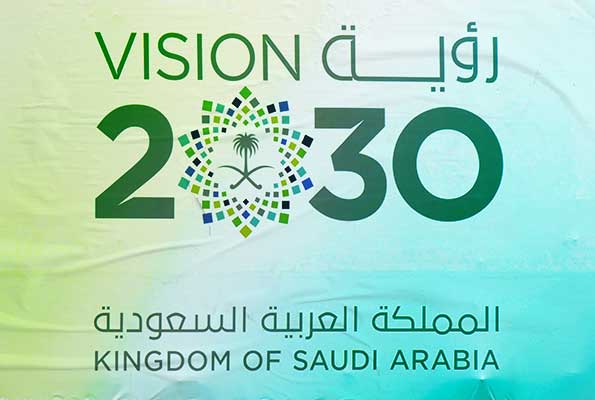According to Goldman Sachs Research, Saudi Arabia’s effort to expand its economy beyond oil, under its ambitious ‘Vision 2030’ roadmap, is having a ground impact. And yes, the statement holds a solid value, which today’s article will talk about.
The National Investment Strategy (NIS), a program to alter the Saudi government’s economy through increased support for innovation, incentives to increase private sector contributions, and targeted support for important sectors, was introduced in 2021.
Goldman projects that up to USD 1 trillion in early investments in six distinct industries, including clean technology, metals, mining, transport, and logistics, might be made by the end of the decade (a portion of the total expected NIS investments of USD 3.3 trillion). By 2030, the nation intends to complete eight “mega projects” worth USD 870 billion, one of which is the NEOM project, a futuristic city on the Saudi side of the Gulf of Aqaba.
In the team’s research, Goldman Sachs Research analyst Faisal AlAzmeh states, “We also expect more strategies and announcements as initial targets are met, supported by further technological breakthroughs across sectors.”
Understanding The Benefits Of These Investments
Six sectors, according to Goldman Sachs Research, are already gaining from higher investment and are anticipated to fuel a “capex supercycle” through the end of the decade.
Firstly, there is cleantech. By 2030, Saudi Arabia intends to increase its nuclear energy capacity by two to three gigawatts (GW) and its capacity for renewable energy by about 60 GW. Additionally, it aims to enhance the manufacture of electric and clean hydrogen vehicles. USD 206 billion is the estimated total investment.
Then there are benefits for the mining industry. In 2021, the government unveiled a new mining investment law designed to speed up the granting of exploration permits and capitalize on an estimated USD 1.3 trillion in “vastly unexplored” metals and minerals. Estimated total investment: USD 170 billion.
The nation recently unveiled a revamped National Transport and Logistics Strategy, a Saudi Aviation Strategy, and a new national airline to establish itself as a major shipping and transport hub. Additionally, the King Salman International Airport expansion is planned. USD 150 billion is the estimated total investment.
It’s also helpful with digital transformations. The cornerstone of Saudi Arabia’s economic goals is capital spending by the country’s telecommunications companies, with investments concentrated on network capacity, particularly 5G and fiber-to-the-home developments. Estimated total investment: $147 billion.
Finally, there are energy benefits. The increase of oil and natural gas production capacity is a key component of the strategy, and conventional energy production still plays a significant role in the country’s economic plan. USD 245 billion is the estimated total investment.
According to the plan, demand for petrochemical products is expected to grow faster than that for gasoline and diesel, which will encourage investment in fields such as crude oil to chemicals technology. Estimated total investment: USD 100 billion.
What NIS Policy Does The Kingdom Follow?
The NIS is more widely focused on enhancing the role of FDI, which is anticipated to increase to 3.4% of GDP by 2025 and 5.7% by 2030. Gross fixed capital creation, which presently accounts for nearly a quarter of Saudi Arabia’s GDP, is anticipated to increase to 26.4% by 2025 and 30% by 2030.
The government’s plan to overhaul its economy, Vision 2030, which was unveiled in 2016, is intended to be made possible via the NIS. “Since the launch of Vision 2030 in 2016, Saudi Arabia has made meaningful strides in growing the non-oil economy through various developments and investments across strategic economic sectors,” says AlAzmeh.
Shareek, a program launched in 2021 to increase domestic investment by listed and non-listed private sector enterprises to USD 1.3 trillion by 2030, is another important component of the NIS. Saudi Arabia expects the program, which is made up of 28 private companies, to increase non-oil exports from 16% to 50%. On March 1 of this year, the government unveiled the first round of Shareek-supported projects for big businesses.
Since unveiling Vision 2030, Saudi Arabia has achieved immense progress.
Saudi Arabia is in a unique position to keep its promises because of the wealth that oil has brought it. Our MENA Financials analysts point out that the country’s international investment position increased by USD 150 billion between the first quarters of 2021 and 2023 alone due to large oil gains.
Some of the biggest sovereign wealth funds in the world are located in Saudi Arabia, notably the Public Investment Fund, whose assets under administration increased from USD 250 billion in 2018 to nearly USD 700 billion in 2019.
“Since the launch of Vision 2030 in 2016, Saudi Arabia has made meaningful strides in growing the non-oil economy through various developments and investments across strategic economic sectors,” AlAzmeh said.
As sector objectives are set, investment plans are anticipated to advance along with technical development and availability throughout time.



